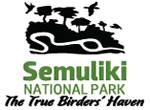Semuliki National Park- SNP is one of the untouched tourist destinations offering authentic wilderness experiences to nature lovers on Uganda safaris. There are lots of exciting and unique Uganda safari activities for tourists to be part while on safari in Semuliki NP.
Situated in Western Uganda, Semuliki National Park shelters part of the extensive Ituri Forest. This splendid Uganda National Park covers 220sq.kms of land area with elevation range of 670 to 760m. Semuliki NP protects diversity of wildlife including up to 60 mammal species (chimpanzees, colobus monkeys, elephants, hippos, buffaloes), reptiles, over 441 bird species, amphibians and more.
Top Safari Activities in Semuliki National Park SNP- Uganda
Guided game drives
Game drive is Semuliki National Park’s top safari activity, best enjoyed in a comfortable 4×4 safari vehicle. A game drive in Semuliki NP is best conducted early morning, afternoon and night. The likely animal species to keep an eye on while on Semuliki National Park safari game drive include warthogs, waterbucks, elephants, buffaloes, birds, Kobs, hyenas, birds and more.
Birding
Semuliki NP is undoubtedly one of Uganda’s unique birding destinations, offering nature lovers an incredible opportunity to sight diversity of birds including Albertine rift endemic species. Semuliki N/Park alone protects 441 bird species including shoebill storks, red billed dwarf hornbill, Swamp palm bulbul, yellow throated cuckoo, dwarf honeyguide, turacos, yellow throated nicator, orange weaver, purple breasted sunbird, red rumped tinker bird, chestnut flanked goshawk, white throated blue swallow, black casqued wattled hornbill and others. The important birding trails of Semuliki NP include Semuliki River, Ntandi, Sempaya and Kirumia trail.
Boat cruise
Boat cruise in Semuliki NP allows visitors enjoy a close view of aquatic life such as hippos, crocodiles and water birds. In Semuliki NP, a boat cruise is done on River Semuliki connecting to Lake Albert. R. Semuliki extends from Mt. Rwenzori to Lake Albert about 160kms and visitors have more than hippos or crocodiles to see as there is a chance to also enjoy excellent view of the surrounding areas especially the Rift Valley escarpments etc.
Primate walk/tracking
Primate walk is such an interesting nature activity Semuliki National Park has to offer the world. Tourists on primate walk in Semuliki NP get to enjoy a close interaction with lots of primates ranging from the grey cheeked mangabeys, olive baboons, chimpanzees, vervet monkeys, red tailed monkeys, colobus monkeys, bush babies and more.
Sempaya hot springs tour
Visiting the powerful Sempaya Hot Springs should be a must do while on Uganda safari in Semuliki National Park. The park is comprised of female and male hot spring with female (Nyasimbi) known for its boiling rate of over 100 degrees Celsius. Male Sempaya hot springs is referred to as Bintente and this is located in the swampy area with diameter of about 12m.
It is at Nyasimbi where visitors can perform a quick experiment of boiling eggs and bananas etc. On a guided nature walk to these hot springs, visitors have opportunity to keep an eye on a number of species such as black and white colobus monkeys, red tailed monkeys, grey cheeked mangabeys, birds etc.
Nature walks
Nature walks in Semuliki NP, a great opportunity to explore and experience the hidden treasures of this untapped national park. There are lots of interesting nature trails to embark on a guided nature walk including the red monkey trail which is 11kms long taking nature lovers up to Semliki River with a chance to spot the DeBrazza monkeys. The Sempaya trail, an amazing trail taking visitors via a lush forest while keeping an eye on red tailed monkeys, grey cheeked mangabeys, colobus monkeys etc. Kirumia trail 13 kms trail connects up to Semuliki river traversing via the forest and it is interestingly, the best birding trail.
Community visit/cultural encounters
Community/cultural encounters at Semuliki NP are best done in the adjacent local communities. Visit the adjacent local communities and stand a chance to interact, learn more about the hunting, gathering techniques the Batwa used, norms, lifestyles, traditions etc.
